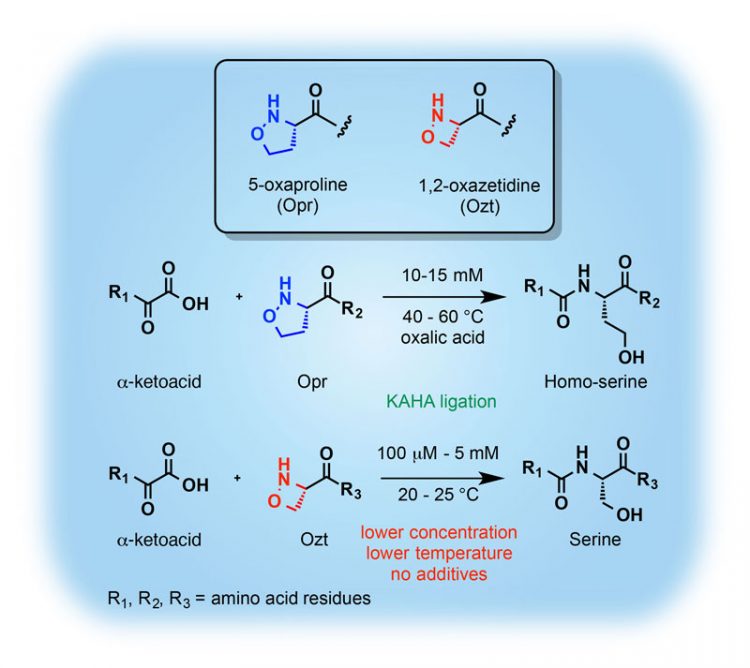Rapid chemical synthesis of proteins by a new amino acid partner

Copyright : ITbM, Nagoya University
The development of new methods for the chemical synthesis of proteins is highly significant to access a range of proteins inaccessible by conventional approaches. Dr. Ivano Pusterla and Prof. Jeffery Bode of ETH-Zürich and Nagoya University's Institute of Transformative Bio-Molecules (ITbM) have succeeded in the first synthesis of oxazetidine amino acids as a new ligation partner for the rapid and chemoselective synthesis of proteins.
Oxazetidine is a hydroxylamine in a four-membered ring form and exhibits high reactivity arising from its ring strain. The KAHA ligation reaction developed by Bode’s group has been used to synthesize various proteins by the reaction between α-ketoacids and oxaprolines, a five-membered hydroxylamine ring. One limitation of this previous reaction system was that a non-native homoserine residue is introduced in the ligation site.
In this study, Bode has showed that oxazetidine-containing peptides react with α-ketoacids to undergo KAHA ligation at lower concentrations and at milder temperatures to produce proteins that contain native serine residues. The oxazetidine amino acid is formally an oxidized form of serine, which has a relatively high abundance and can replace other amino acid residues without affecting the overall folding or function of proteins.
This reaction system was applied towards the synthesis of a 100-residue calcium-binding protein, S100A4, which is usually difficult to access by native chemical ligation or other amide-forming reactions. The high reaction rate, chemoselectivity and versatility of this new native amide-forming ligation reaction using oxazetidine amino acids is envisaged to become a powerful method for the rapid chemical synthesis of useful proteins.
This article “An oxazetidine amino acid for chemical protein synthesis by rapid, serine-forming ligations” by Ivano Pusterla & Jeffrey W. Bode is published online on June 23, 2015 in Nature Chemistry as an Advanced Online Publication.
DOI: 10.1038/nchem.2282 ( http://dx.doi.org/10.1038/nchem.2282 )
About WPI-ITbM ( http://www.itbm.nagoya-u.ac.jp/ )
The World Premier International Research Center Initiative (WPI) for the Institute of Transformative Bio-Molecules (ITbM) at Nagoya University in Japan is committed to advance the integration of synthetic chemistry, plant/animal biology and theoretical science, all of which are traditionally strong fields in the university. As part of the Japanese science ministry’s MEXT program, ITbM aims to develop transformative bio-molecules, innovative functional molecules capable of bringing about fundamental change to biological science and technology. Research at ITbM is carried out in a “Mix-Lab” style, where international young researchers from multidisciplinary fields work together side-by-side in the same lab. Through these endeavors, ITbM will create “transformative bio-molecules” that will dramatically change the way of research in chemistry, biology and other related fields to solve urgent problems, such as environmental issues, food production and medical technology that have a significant impact on the society.
Author Contact
Professor Jeffrey Bode
Institute of Transformative Bio-Molecules (WPI-ITbM), Nagoya University
Furo-Cho, Chikusa-ku, Nagoya 464-8601, Japan
E-mail: bode@itbm.nagoya-u.ac.jp
ETH-Zürich
Laboratory of Organic Chemistry
HCI F 315, Wolfgang-Pauli-Strasse 10
8093 Zürich, Switzerland
Tel: +41-44-633-2103
E-mail: bode@org.chem.ethz.ch
Public Relations Contact
Dr. Ayako Miyazaki
Institute of Transformative Bio-Molecules (WPI-ITbM), Nagoya University
Furo-Cho, Chikusa-ku, Nagoya 464-8601, Japan
TEL: +81-52-789-4999 FAX: +81-52-789-3240
E-mail: press@itbm.nagoya-u.ac.jp
Nagoya University Public Relations Office
TEL: +81-52-789-2016 FAX: +81-52-788-6272
E-mail: kouho@adm.nagoya-u.ac.jp
Associated links
ITbM Nagoya University article
Journal information
Nature Chemistry
Media Contact
More Information:
http://www.researchsea.comAll latest news from the category: Life Sciences and Chemistry
Articles and reports from the Life Sciences and chemistry area deal with applied and basic research into modern biology, chemistry and human medicine.
Valuable information can be found on a range of life sciences fields including bacteriology, biochemistry, bionics, bioinformatics, biophysics, biotechnology, genetics, geobotany, human biology, marine biology, microbiology, molecular biology, cellular biology, zoology, bioinorganic chemistry, microchemistry and environmental chemistry.
Newest articles

Superradiant atoms could push the boundaries of how precisely time can be measured
Superradiant atoms can help us measure time more precisely than ever. In a new study, researchers from the University of Copenhagen present a new method for measuring the time interval,…

Ion thermoelectric conversion devices for near room temperature
The electrode sheet of the thermoelectric device consists of ionic hydrogel, which is sandwiched between the electrodes to form, and the Prussian blue on the electrode undergoes a redox reaction…

Zap Energy achieves 37-million-degree temperatures in a compact device
New publication reports record electron temperatures for a small-scale, sheared-flow-stabilized Z-pinch fusion device. In the nine decades since humans first produced fusion reactions, only a few fusion technologies have demonstrated…





















